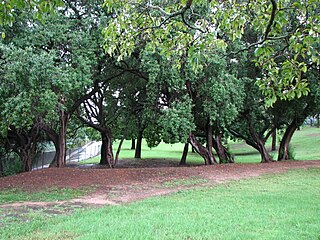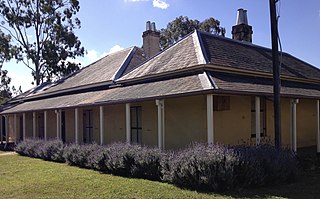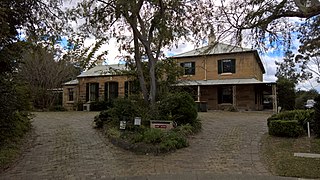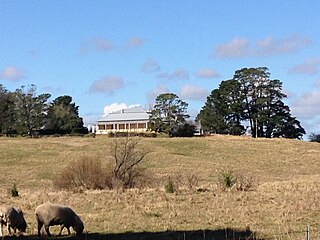
Experiment Farm Cottage is a heritage-listed former farm and residence and now house museum at 9 Ruse Street, Harris Park, City of Parramatta, Sydney, Australia. It is one of Australia's oldest standing residences, being built in c.1834. It is located at the site of Experiment Farm, Australia's first European farmstead, which was itself created by Australia's first land grant. It was added to the New South Wales State Heritage Register on 2 April 1999.

Vaucluse House is a heritage-listed residence, colonial farm and country estate and now tourist attraction, house museum and public park, formerly the home of statesman William Charles Wentworth and his family. It is located at 69a Wentworth Road, Vaucluse in the Municipality of Woollahra local government area of New South Wales, Australia. Completed between 1803 and 1839 in the Gothic Revival style, its design was attributed to W. C. Wentworth and built by Sir Henry Browne Hayes and W. C. Wentworth. The property is owned by the Historic Houses Trust of New South Wales, an agency of the Government of New South Wales. The site was added to the New South Wales State Heritage Register on 2 April 1999.

The Camden Park Estate incorporating the Belgenny Farm is a heritage-listed large working historical farm located at Elizabeth Macarthur Avenue, in the south-western Sydney suburb of Camden South in the Camden Council local government area of New South Wales, Australia. It was designed by Henry Kitchen in c. 1800, John Verge in c. 1835 and A. J. Onslow in c. 1888 and built from 1819 to 1840 by John Macarthur in c. 1800, James English and Sons in c. 1888 and John Sulman c. 1895. The property is owned by Belgenny Farm Trust and Camden Park Preservation Committee. It was added to the New South Wales State Heritage Register on 22 December 2006. Today, part of the original estate contains the Elizabeth Macarthur Agricultural Institute; having originally served as a commercial sheep station and horticultural farm for the Macarthur family since the early 1800s.

Cooma Cottage is a heritage-listed former farm and tuberculosis sanatorium and now house museum and historic site at Yass Valley Way, Marchmont, Yass Valley Shire, New South Wales, Australia. It was built from 1830 to 1837 by Cornelius and Rebecca O'Brien. It is also known as Hamilton Hume's House,Humedale Stud, and New Nordrach Institute for Consumption. The property is owned by the National Trust of Australia (NSW). It was added to the New South Wales State Heritage Register on 1 March 2002.

Eryldene is a heritage-listed former family residence and now house museum located at 17 McIntosh Street in the Sydney North Shore suburb of Gordon, Australia. It was designed by William Hardy Wilson and built from 1913 to 1936 by Rudolph G. Ochs. The property is owned by The Eryldene Trust. The house and its garden, which is noted for its camellias was added to the New South Wales State Heritage Register on 2 April 1999 and was listed on the Australian Register of the National Estate.

Rouse Hill Estate is a heritage-listed homestead and estate off Windsor Road, Rouse Hill, City of Blacktown, New South Wales, Australia. Rouse Hill House and farm was the family home of Richard Rouse, the Colonial Superintendent of Public Works and Convicts at Parramatta.

Yasmar is a heritage-listed house at 185 Parramatta Road, Haberfield, Inner West Council, Sydney, New South Wales, Australia. It has variously served as a private home, Sunday school, children's court and juvenile remand and detention centre, and is now used by community groups and as a correctional services training facility. It was designed by John Bibb and built from 1856 to 1858. The surrounding site has also been known as Yasmar Hostel, Yasmar Detention Centre, Yasmar Child Welfare Home, Ashfield Remand Home, Yasmar Shelter and the Yasmar Juvenile Justice Centre. The property is owned by Land and Property Management Authority (LPMA). It was added to the New South Wales State Heritage Register on 18 February 2000.

The Bunyas is a heritage-listed residence and former church missionary and scout headquarters at 5 Rogers Avenue, Haberfield, Inner West Council, Sydney, New South Wales, Australia. It was designed by John Spencer-Stansfield and built from 1900 to 1907. It is also known as Stanton Residence. It was added to the New South Wales State Heritage Register on 2 April 1999.

Silverwater Prison Complex Conservation Area is a heritage-listed complex consisting of a historic house and various prison structures associated with what is now known as the Silverwater Correctional Complex, located at Holker Street, Silverwater, Cumberland Council, New South Wales, Australia. It was designed by John Verge and Walter Liberty Vernon and built from 1829 to 1850. It is also known as Silverwater Correctional Centre, Mulawa Correctional Centre, Silverwater Gaol, Newington Estate, Silverwater State Hospital and State Hospital & Asylum for Women. The property is owned by Corrective Services NSW. It was added to the New South Wales State Heritage Register on 2 April 1999.

Bella Vista is a heritage-listed residence at Elizabeth Macarthur Drive, Bella Vista, The Hills Shire, New South Wales, Australia. It was built from 1830 to 1960. It is also known as Kings Langley, Stock Farm, Seven Hills Farm and Bella Vista Farm. The property is owned by The Hills Shire Council and was added to the New South Wales State Heritage Register on 2 April 1999.

Elizabeth Farm Reserve is a heritage-listed public reserve on former farmland associated with Elizabeth Farm, located at Arthur Street, Rosehill, City of Parramatta, New South Wales, Australia. The property is owned by Parramatta City Council. It was added to the New South Wales State Heritage Register on 2 April 1999.

Addington House is a heritage-listed former farm, residence and orchard and now community facility located at 813 Victoria Road, Ryde in the City of Ryde local government area of New South Wales, Australia. It was built from 1794 to 1841 in different stages by James Stewart, James Shepherd, Thomas Bowden. It is also known as New Farm. The property is owned by City of Ryde. It was added to the New South Wales State Heritage Register on 2 April 1999.

Brislington is a heritage-listed former residence, inn, doctor's surgery, nurses' home and now museum at 10 George Street, Parramatta, Sydney, New South Wales, Australia. It was built from 1819 to 1821 by John Hodge. Incorporated into the former Parramatta District Hospital for many years, it now serves as the Brislington Medical and Nursing Museum. The property is owned by the New South Wales Department of Health. It was added to the New South Wales State Heritage Register on 2 April 1999.

Broughton House is a heritage-listed former residence, school and now nursing home at 43a Thomas Street, Parramatta, Sydney, New South Wales, Australia. It was built from 1838 and was possibly designed by John Verge. It has also been known as Newlands, Bowden House, Parramatta Convalescent Home and Parramatta Nursing Home. It was added to the New South Wales State Heritage Register on 1 October 1999.

Hambledon Cottage is a heritage-listed former residence and now house museum at 47 Hassall Street, Harris Park, City of Parramatta, Sydney, New South Wales, Australia. The cottage was built from 1821 to 1825, with the initial section being designed by Henry Kitchen. It is also known as Firholme, Valley Cottage and Macarthur Cottage. The property is owned by Parramatta City Council. It was added to the New South Wales State Heritage Register on 21 September 2012.

Macarthur House is a heritage-listed former residence and school building and now offices at 8 Melville Street, Parramatta, City of Parramatta, Sydney New South Wales, Australia. It was designed by James Houison, Arthur William McKenzie Mowle and David Sheedy and built from 1855 to 1856 by James Houison. It has also known as Morton House and Pemberton Grange. It was added to the New South Wales State Heritage Register on 2 April 1999.

Throsby Park is a heritage-listed homestead at Church Road, Moss Vale, Wingecarribee Shire, New South Wales, Australia. It was built from 1820 to 1836. The property is owned by the Historic Houses Trust of New South Wales, but is leased to banker Tim Throsby of Barclays, a descendant of the original owners. It was added to the New South Wales State Heritage Register on 2 April 1999.

Jarvisfield is a heritage-listed former pastoral property and now golf course at Old Hume Highway, Picton, Wollondilly Shire, New South Wales, Australia. It was designed by William Weaver, architect-engineer, and built from 1815 to 1864. It is also known as Wilton. The property is owned by the Wollondilly Shire Council. It was added to the New South Wales State Heritage Register on 2 April 1999.
Brownlow Hill Estate is a heritage-listed former residence and working farm and now residence and dairy farm located at Brownlow Hill Loop Road in the outer south-western Sydney settlement of Brownlow Hill in the Wollondilly Shire local government area of New South Wales, Australia. It was designed and established by Alexander Macleay and built from 1827 by George Macleay, his son). It is also known as Lowe's Hill and Glendaruel (Glendaurel). The property is privately owned. It was added to the New South Wales State Heritage Register on 25 January 2001.

Lyndhurst is a heritage-listed residence and former school, laundry, maternity hospital and industrial building located at 61 Darghan Street in the inner western Sydney suburb of Glebe in the City of Sydney local government area of New South Wales, Australia. It was designed by John Verge and built from 1833 to 1837. The property is owned by Historic Houses Trust of New South Wales. It was added to the New South Wales State Heritage Register on 2 April 1999.





















